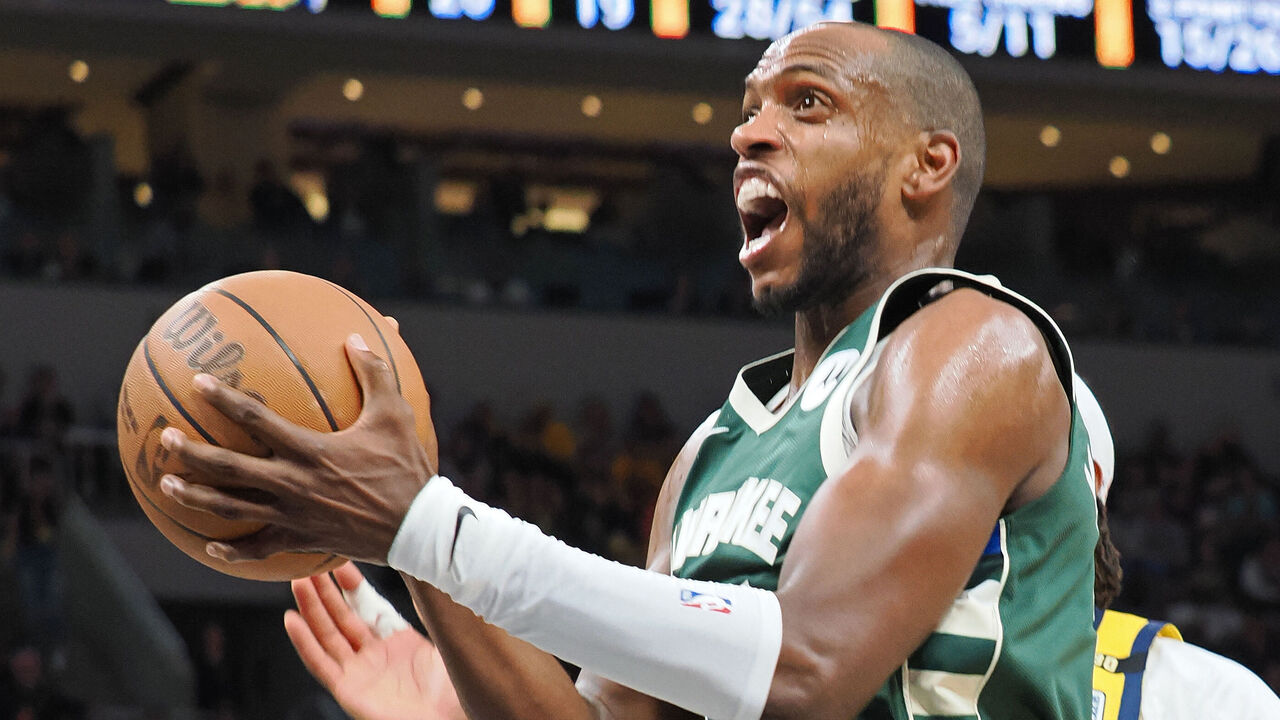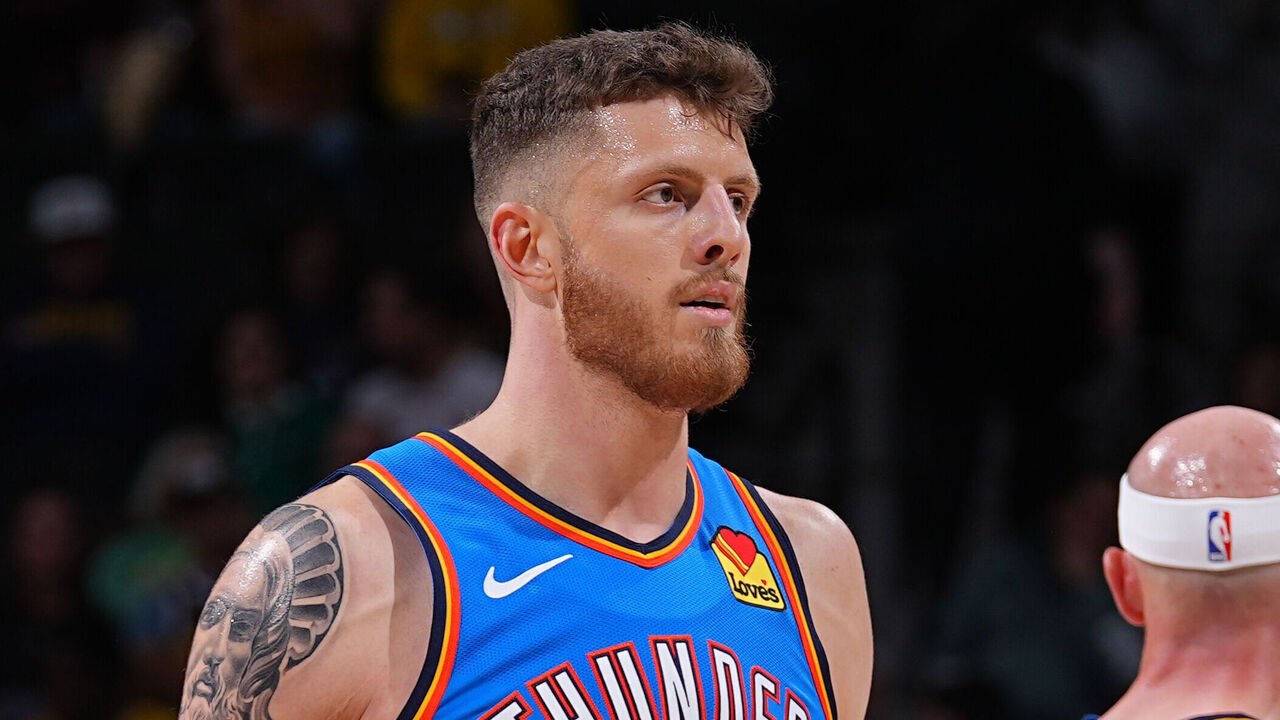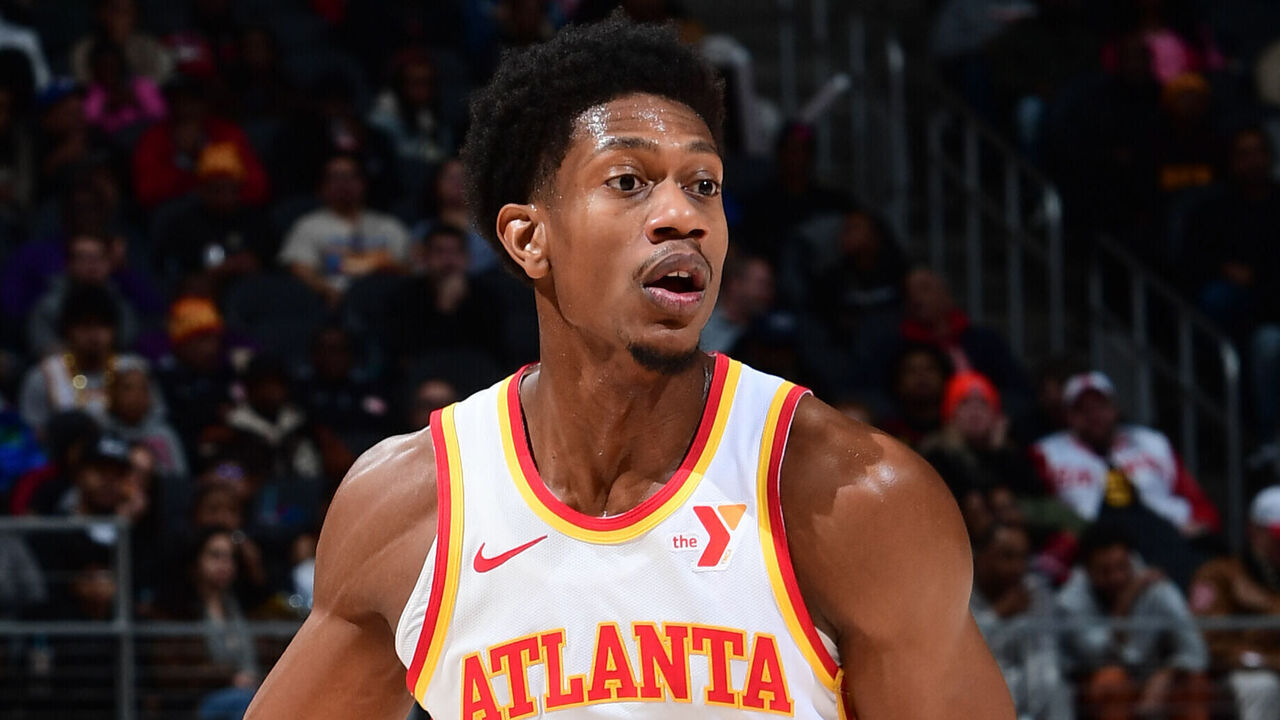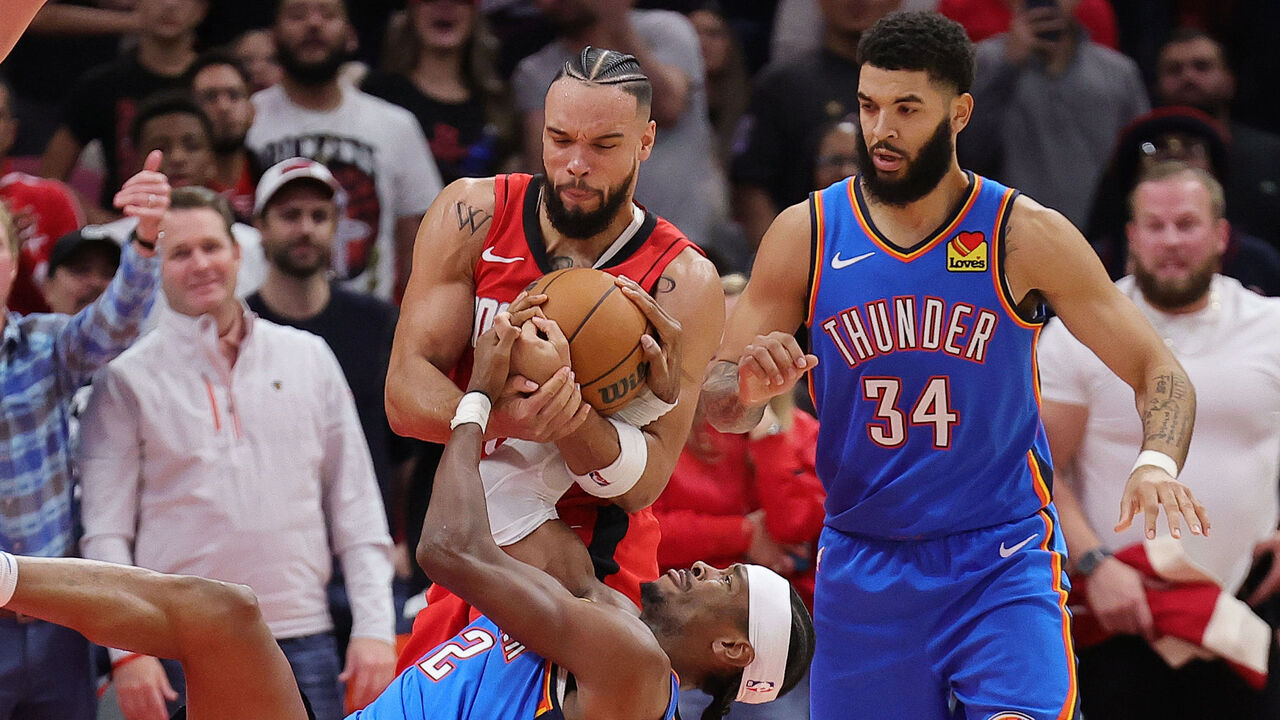1 player to watch on each NBA Cup semifinalist
The Milwaukee Bucks, Atlanta Hawks, Oklahoma City Thunder, and Houston Rockets are in Las Vegas ready to duke it out for the second annual NBA Cup. With the semifinals set to tip off Saturday night, here's one interesting player to keep an eye on for each remaining team.
Middleton makes the Bucks make sense
Khris Middleton has looked a bit rusty as a scorer since returning from double ankle surgery and making his season debut last week. He's on a minutes restriction that's kept him to 21 per night, he doesn't fully have his legs under his jumper, and he's been tentative as a driver, with just two of his 20 field-goal attempts coming at the rim. He's hit just five of those 20 shots and is averaging 7.3 points in his three games back after going scoreless in Milwaukee's win over Orlando in the Cup quarterfinals.
And yet, it's hard to overstate how much Middleton's steady hand has helped connect the dots and smooth things out for a Bucks team that often looked shambolic without him. Just having another capable ball-handler and passer who can pilot the offense has been a huge boon, both with and without Damian Lillard on the floor. Having him as a co-creator will be all the more important with Lillard presumably being shadowed by Dyson Daniels in the semis.

For now, Middleton is coming off the bench and basically serving as the team's backup point guard. In that role, he's averaging 6.3 assists per game, or 10.9 per 36 minutes. Even with his aforementioned scoring struggles, Milwaukee has won his minutes by 19.1 points per 100 possessions, with a 128.8 offensive rating. Part of that can be attributed to how tightly Doc Rivers has tethered him to Giannis Antetokounmpo; of Middleton's 63 minutes, 61 have come with Antetokounmpo on the court. As such, 13 of his 19 assists have gone to Antetokounmpo, mostly out of the pick-and-roll.
While Lillard and Antetokounmpo have refined their chemistry over time, Giannis' two-man game with Middleton has always been more effective. Reuniting the pair has allowed Antetokounmpo to relinquish some of his onerous initiating responsibilities and lean much further into play-finishing. When he plays without Middleton, 62% of his 2-point field goals are unassisted. When Middleton's on the floor with him, that proportion of self-created twos shrinks all the way down to 23%.
At 33 years old and after multiple lower-body surgeries, Middleton obviously isn't the on-ball defender he once was. But he's still a smart team defender who helps on that end simply by being in the right place at the right time (something that can't always be said for Gary Trent Jr. or Taurean Prince). On two separate occasions in Tuesday's quarterfinal, he forced turnovers on back-to-back possessions with heady off-ball plays.
In the first half, he picked off an Anthony Black skip pass while playing the weak-side zone and followed it up by sliding over to draw a charge on a cutting Wendell Carter Jr. In the second half, he stunted from the slot and stripped Black coming off a corner dribble-handoff, then on the next possession dug down for a steal on a driving Moe Wagner while playing on the bottom end of a 2-3 zone. He followed up both of those second-half steals by setting Antetokounmpo up for dunks at the other end.
His scoring will come around eventually. For now, it's just great to see him back on the court, contributing in myriad other ways.
Hartenstein fills in the blanks for OKC
All the reasons the Thunder saw fit to shell out a big free-agent contract to Isaiah Hartenstein have been on display since the big man returned from a hand fracture three weeks ago, and they were there for everyone to see in the team's quarterfinal win over the Dallas Mavericks.
The Thunder lost to the Mavericks in the second round this past spring after getting beat up on the glass and generally overwhelmed physically. On Tuesday night, it was the exact opposite. While Hartenstein wasn't the sole reason for that, he certainly had a lot to do with OKC turning the tables on Dallas, which included winning the offensive rebounding battle 17-7.

Hartenstein, whose proficiency as a rebounder was a huge part of why he was acquired, hauled in five of those 17 O-boards, on top of all the pointy-elbowed work he did to limit second chances on the defensive end. Before he returned to the lineup, the Thunder ranked dead last in the NBA in overall rebound rate (46.3%). Their rebound rate with him on the floor (52.4%) would rank second. That's going to be pretty important in the semifinals against the Rockets, who happen to lead the league in that category.
Hartenstein also showcased his defensive coverage versatility and rim-protecting chops, holding the Mavs to 1-for-5 shooting at the basket while also containing Luka Doncic and Kyrie Irving on the perimeter with hard shows in ball-screen action. Blitzing Doncic is a dangerous tactic, but Hartenstein's mobility and back-line deterrence made it pay off. For the season, the Thunder's opponent rim frequency dips by 8.1 percentage points, per Cleaning the Glass. Among players challenging at least five rim shots per game, only six guys have allowed a lower percentage on those shots than Hartenstein (50.9%), and one of them is Chet Holmgren.
At the offensive end, second-chance generation is just one way Hartenstein helps the Thunder. They take advantage of his passing chops by running a ton of Delay action through him at the top of the floor, which throws a different wrench at defenses after being largely absent from OKC's toolkit last season. He leads the team by a mile in frontcourt touches per game, averaging about 12 more than Holmgren was getting before his injury. And to the earlier point about their physicality shift, he brings a screening presence the Thunder previously lacked. For all his gifts, Holmgren has a hard time making solid contact without getting dislodged due to his slender frame and is often more interested in slipping than truly connecting.
There's more than one way to create space as a big man. Holmgren does it by drawing opposing centers out of the paint with his jump-shooting ability; Hartenstein does it by laying lumber and wiping on-ball defenders out of the picture. The latter has proved just as beneficial as the former for lead guards Shai Gilgeous-Alexander and Jalen Williams - especially for Williams, who's a bit more reliant on screens to create good shots for himself. Gilgeous-Alexander's true shooting percentage jumps from 61% to 63.4% with Hartenstein on the floor, while Williams' spikes from 58.8% to 60.6%.
On top of making life easier for others, Hartenstein is an effective - if unconventional - pick-and-roll finisher. He has, without exaggeration, one of the five most accurate push shots in the league. He's taken 48% of his shots from floater range this season, the highest frequency for any qualified player, and made 52% of them. He's developed crackling two-man chemistry with Williams, whose tempo and patience help guide him not only into those short-roll floaters but into the occasional lob dunk. The two of them linked up for three alley-oops against the Rockets the last time the two teams played.
Hartenstein's matchup with Houston's offensive fulcrum, Alperen Sengun, will be fascinating to watch at both ends and will have a lot to say about which team advances to the Cup final.
Hunter leveling up for the Hawks
Atlanta is the most surprising entry in the Cup's Final Four, and there's excitement building over a team that looks and feels different from its past iterations.
A lot of that excitement centers on the Hawks' more novel components, from the outrageous defense being played by trade import Dyson Daniels, to the continuing evolution of young playmaking forward Jalen Johnson, to the encouraging two-way flashes shown by No. 1 pick Zaccharie Risacher. Quietly, though, one of the most important developments for the team this season involves one of its longtime holdovers: a post-hype wing who's finally fulfilling his potential while transitioning to a sixth-man role in his age-27 campaign.

De'Andre Hunter was once an intriguing two-way prospect in his own right, but as injuries piled up, his growth stagnated. Over five mildly disappointing campaigns, his defense waxed and waned, his jumper came and went, and more than anything, his offensive decision-making lagged behind. He did make some strides in that department last season, but this year represents a quantum leap by comparison. This is a considerably more assured, more decisive, more forceful version of Hunter than we've ever seen.
It obviously helps that he's shooting 45% from deep, and it's fair to wonder how different things will look when that inevitably regresses. But it feels just as important that Hunter is letting those threes fly - or attacking the closeouts he's garnering - with conviction and without hesitation. Gone are the record-scratches and meandering dribbles to nowhere. In their place are stampede cuts and straight-line drives. His handle also looks more fluid on the rare occasions that he moves horizontally with the ball.
The upshot is that he's not only taking a higher rate of threes than ever, he also has by far the highest free-throw rate of his career. He's almost entirely excised long mid-rangers from his diet; they account for just 6% of his field-goal attempts this season, less than half his previous career-low frequency. Pull-up jumpers in general make up just 23% of his shots, the lowest proportion of his career and down from over 30% each of the last two years. And he's shooting 71% at the rim, besting his career high of 64%.
Add it all up, and Hunter is the NBA's leading bench scorer at 19.6 points per game (25.4 per 36 minutes) on 63.8% true shooting. He's still a maddeningly inconsistent defender, especially off the ball, and he's never going to be any kind of playmaker. But he appears to have settled into his ideal offensive role, and the Hawks are scoring 7.2 more points per 100 possessions with him on the floor. He's scored 20 or more points in seven of his last eight games, and against a Bucks team that's extremely light on perimeter defense, he should be poised to make it eight of nine.
Brooks binds Houston's defense
There are lots of reasons the Rockets currently rate as the second-best defensive team in the NBA: their creative head coach, their army of young octopus-armed chaos agents, and their 6-foot veteran point guard. But Dillon Brooks, whose arrival last season kickstarted the transformation of what was then the league's second-worst defense, is still the glue that binds the structure together.

"We're only as good as our one-on-one defense," Ime Udoka told The Ringer's Michael Pina, and for as dynamic and disruptive as Amen Thompson and Tari Eason are, the Rockets have no better one-on-one irritant than Brooks, whether he's manning up a point guard or a center. They allow 9.8 fewer points per 100 possessions with him on the floor, the largest differential on the team.
Brooks isn't an event creator the way Thompson, Eason, or even Fred VanVleet is. He's more of an event preventer. His impact lies in the things that don't happen, the plays that don't materialize because of his ball denial and ability to stay stapled to ball-handlers' hips. He doesn't get many steals, but he'll still force turnovers by drawing moving-screen violations because he's adept at evading stationary picks.
As such, the task of trying to corral the tornado that is Shai Gilgeous-Alexander will largely fall to him in the semis. He did an admirable job of it in the teams' last meeting, which Houston won, despite SGA shaking loose for 32 points.
Brooks has also been by far the most accurate 3-point shooter (38.1%) on one of the league's worst 3-point shooting teams. Against a Thunder defense that swarms the middle and concedes a ton of threes, the Rockets will rely on him to make them pay for their aggressive help. So, in short, he'll be central to what transpires at both ends of the floor.
Joe Wolfond covers the NBA for theScore.